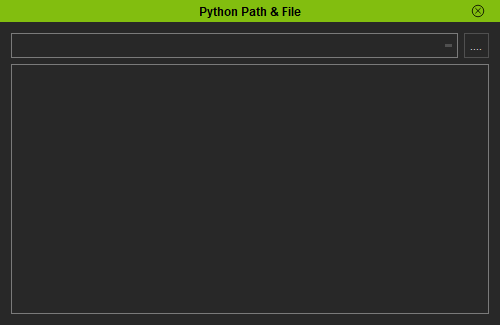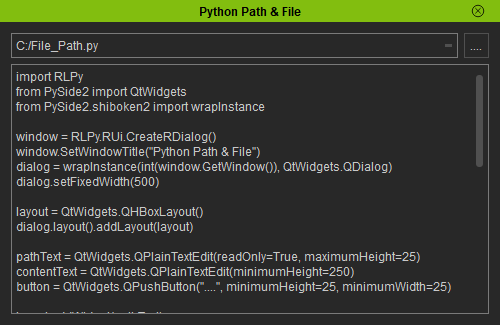Difference between revisions of "IC Python API:File Path"
Chuck (RL) (Talk | contribs) m |
Chuck (RL) (Talk | contribs) m |
||
| Line 4: | Line 4: | ||
Oftentimes, you'll need to handle external files in the form of loading, writing and reading. This article will go over doing just that with Python scripting. | Oftentimes, you'll need to handle external files in the form of loading, writing and reading. This article will go over doing just that with Python scripting. | ||
| − | + | == Required Modules == | |
Besides the rudimentary Reallusion Python API, we'll need to use Qtwidgets to build our user interface and shiboken2 to convert the dialog window to something Python can understand. | Besides the rudimentary Reallusion Python API, we'll need to use Qtwidgets to build our user interface and shiboken2 to convert the dialog window to something Python can understand. | ||
| Line 14: | Line 14: | ||
</syntaxhighlight> | </syntaxhighlight> | ||
| − | + | == User Interface == | |
[[File:Ic_python_api_file_path_01.png|frame]] | [[File:Ic_python_api_file_path_01.png|frame]] | ||
| Line 38: | Line 38: | ||
</syntaxhighlight> | </syntaxhighlight> | ||
| − | + | == File Dialog Request == | |
[[File:Ic_python_api_file_path_02.png|frame]] | [[File:Ic_python_api_file_path_02.png|frame]] | ||
| Line 62: | Line 62: | ||
</syntaxhighlight> | </syntaxhighlight> | ||
| − | + | == Everything Put Together == | |
You can copy and paste the following code into a PY file and load it into iClone via '''Script > Load Python'''. | You can copy and paste the following code into a PY file and load it into iClone via '''Script > Load Python'''. | ||
| Line 105: | Line 105: | ||
</syntaxhighlight> | </syntaxhighlight> | ||
| − | + | === APIs Used === | |
You can research the following references for the APIs deployed in this code. | You can research the following references for the APIs deployed in this code. | ||
Revision as of 19:50, 20 June 2019
- Main article: RL Python Samples.
Oftentimes, you'll need to handle external files in the form of loading, writing and reading. This article will go over doing just that with Python scripting.
Required Modules
Besides the rudimentary Reallusion Python API, we'll need to use Qtwidgets to build our user interface and shiboken2 to convert the dialog window to something Python can understand.
import RLPy
from PySide2 import QtWidgets
from PySide2.shiboken2 import wrapInstance
User Interface
We'll need to create a user interface with a line at the top that shows the directory location, a button for opening the file browse dialog, and a text input to display the contents of the file.
window = RLPy.RUi.CreateRDialog()
window.SetWindowTitle("Python Path & File")
dialog = wrapInstance(int(window.GetWindow()), QtWidgets.QDialog)
dialog.setFixedWidth(500)
layout = QtWidgets.QHBoxLayout()
dialog.layout().addLayout(layout)
pathText = QtWidgets.QPlainTextEdit(readOnly=True, maximumHeight=25)
contentText = QtWidgets.QPlainTextEdit(minimumHeight=250)
button = QtWidgets.QPushButton("....", minimumHeight=25, minimumWidth=25)
layout.addWidget(pathText)
layout.addWidget(button)
dialog.layout().addWidget(contentText)
File Dialog Request
Next we'll need a definition for the file dialog procedure to populate the directory field and the contents text field.
def open_file():
file_dialog = QtWidgets.QFileDialog()
file_dialog.setNameFilter("*.py")
file_dialog.exec()
if(len(file_dialog.selectedFiles()) > 0):
pathText.setPlainText(file_dialog.selectedFiles()[0])
f = open(file_dialog.selectedFiles()[0], "r")
contentText.setPlainText(f.read())
f.close()
button.clicked.connect(open_file)
window.Show()
Everything Put Together
You can copy and paste the following code into a PY file and load it into iClone via Script > Load Python.
import RLPy
from PySide2 import QtWidgets
from PySide2.shiboken2 import wrapInstance
window = RLPy.RUi.CreateRDialog()
window.SetWindowTitle("Python Path & File")
dialog = wrapInstance(int(window.GetWindow()), QtWidgets.QDialog)
dialog.setFixedWidth(500)
layout = QtWidgets.QHBoxLayout()
dialog.layout().addLayout(layout)
pathText = QtWidgets.QPlainTextEdit(readOnly=True, maximumHeight=25)
contentText = QtWidgets.QPlainTextEdit(minimumHeight=250)
button = QtWidgets.QPushButton("....", minimumHeight=25, minimumWidth=25)
layout.addWidget(pathText)
layout.addWidget(button)
dialog.layout().addWidget(contentText)
def open_file():
file_dialog = QtWidgets.QFileDialog()
file_dialog.setNameFilter("*.py")
file_dialog.exec()
if(len(file_dialog.selectedFiles()) > 0):
pathText.setPlainText(file_dialog.selectedFiles()[0])
f = open(file_dialog.selectedFiles()[0], "r")
contentText.setPlainText(f.read())
f.close()
button.clicked.connect(open_file)
window.Show()
APIs Used
You can research the following references for the APIs deployed in this code.



